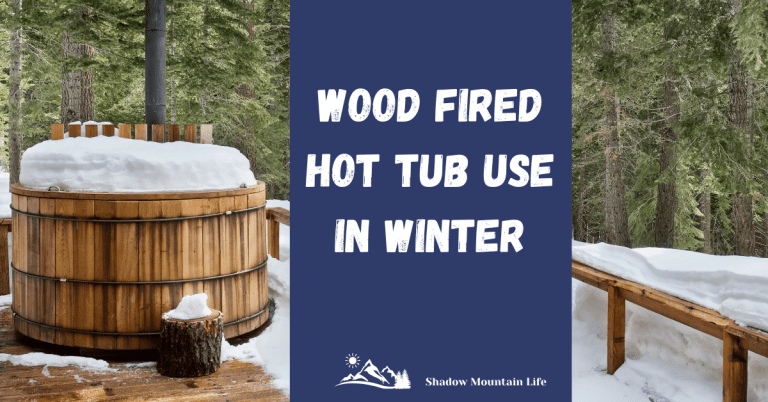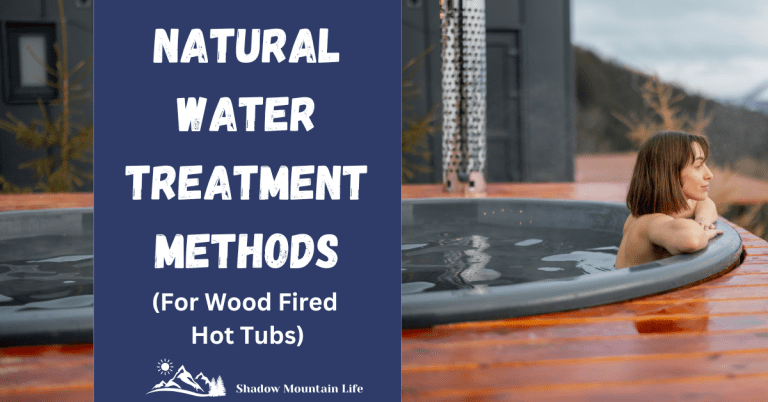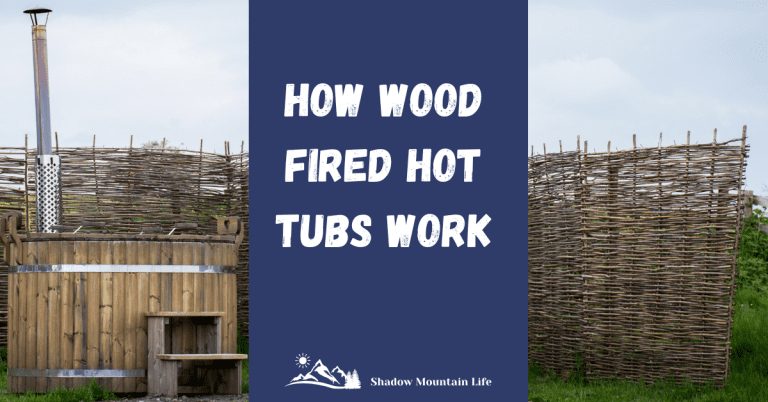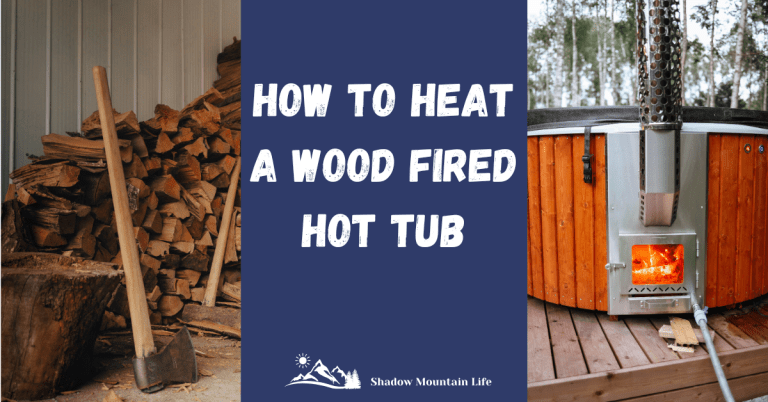Wood Fired Hot Tub Heaters: Internal vs. External – Pros & Cons
Affiliate Disclaimer: We may make a commission if you purchase something through our links. Thank you!
Imagine soaking in steaming hot water under the stars, with only the gentle crackle of burning wood breaking the silence. This is the magic of a wood-fired hot tub. Unlike their electric cousins, these tubs bring us back to nature while still providing all the comfort we crave.
Wood fired hot tubs have seen an increase in popularity lately as people seek more sustainable and authentic outdoor experiences. They offer a unique combination of traditional heating methods with modern comfort, making them perfect for anyone looking to create a natural spa experience in their backyard.
The choice between wood fired hot tub heaters- internal or external heating systems can significantly impact your experience, and we’re here to help you make an informed decision.
However, if you are unfamiliar with the concept of a wood fired hot tub, here’s a little backstory information first.
What Are Wood Fired Hot Tubs?
Wood fired hot tubs represent a perfect blend of old-world charm and modern relaxation. These tubs rely on the simple yet effective method of heating water using wood as fuel, making them independent of electricity and perfect for off-grid locations. Think of them as your personal wilderness spa.
Unlike traditional electric tubs, they don’t require complex electrical systems or expensive monthly electric bills. Instead, they use the age-old practice of heating water with fire to create the same end result-relaxation.
The main difference in wood fired hot tubs styles lies in how the heating system is set up: either inside the tub (submerged stove) or outside (external firebox). This choice affects everything from heating time to maintenance requirements, making it an important decision for potential buyers.

Submerged Stove Systems
How They Work
Submerged stove systems operate on a beautifully simple principle. Inside the tub, a metal stove sits submerged in the water, usually positioned against one wall. This water heater is usually made of steel or aluminum. When you light a fire in the stove, the metal walls heat up and circulate that heat directly to the surrounding water. This creates a natural circulation pattern – hot water rises from around the stove while cooler water sinks to take its place.
This continuous cycle ensures an even way to heat throughout the tub. The stove includes a stove pipe and chimney that extends above the water level to safely vent smoke away from bathers. Safety barriers or fences around the stove protect users from accidentally touching the hot surface while enjoying their soak.

Popular Models
The market offers several outstanding options for submerged wood stove systems. For those seeking traditional charm, look for tubs made from cedar wood or thermowood options that resist decay and stay looking beautiful.
The Sauna Life Model S4N Tub from Nordica Saunas offers an integrated stove accessible through the exterior wall taking up less space than some models on the inside of the tub.
Backcountry Recreation offers a more traditional submerged stove model, as well as integrated wall stove options.
Pros
Submerged stove systems offer several advantages that make them popular choices. First, their direct heat transfer method means faster heating times – you can typically have a hot bath ready in 2-3 hours, compared to longer times with external systems. This efficient heat transfer also means that you will use less wood overall, saving money and resources over time.
The compact design takes up less overall space in your yard, making them perfect for smaller properties or patios.
Cons
While submerged stoves have many benefits, they also come with some drawbacks to consider. The most noticeable is the space the stove takes up inside the tub in most models – it’s like having a permanent guest that never leaves. This reduces the available bathing space and can make it trickier to get in and out of the tub.
Safety is another consideration; even with protective barriers surrounding the firebox, you’ll need to be mindful of the hot stove surface.
Cleaning around the stove can be challenging, requiring some awkward reaching into and around the stove. And special attention must be given to prevent debris buildup and ash getting into the water.
Additionally, the submerged components may need more frequent maintenance to prevent corrosion and ensure safe operation.

External Firebox Systems
How They Work
External firebox systems work like a miniature water heating plant for your hot tub and these stoves are an alternate way of heating your tub. Picture a large stainless steel metal box sitting beside your tub – that’s your firebox. Inside, a series of pipes twist through the firebox, carrying water from your tub through the heated area and back again.
This process relies on thermosiphon circulation, a natural phenomenon where hot water rises and cold water sinks. As water in the pipes gets heated, it naturally flows upward and back into your tub, while cooler water flows down to replace it. This creates a continuous cycle without any need for pumps or electricity.
The system includes insulated pipes to minimize heat loss during transfer, and the whole setup keeps the heating element completely separate from your bathing space freeing up more room inside the tub.
Popular Models
The external wood firebox market offers some impressive options for those seeking luxury and efficiency. Timberline offers external stove models as well as internal in both 2- and 4-person tub sizes.
If you are looking for a small tub, Backcountry Recreation offers a 2-person external stove model.
Each model brings unique features that cater to different needs, from compact designs for small spaces to larger models perfect for entertaining.
Pros
External firebox systems shine in several key areas. The most obvious advantage is the completely unobstructed tub interior – no heater taking up precious soaking space allowing more people to enjoy the tub. This design creates a cleaner, more spa-like experience where you can stretch out and move freely.
Adding wood to the fire is much more convenient since you don’t have to disturb other bathers inside the tub. The separate heating system also means easier maintenance and cleaning of both the tub and the firebox.
Many users appreciate the aesthetic appeal of these systems, as the external firebox can be incorporated into the landscaping design or partially concealed for a more polished look.
Cons
Despite their advantages, external firebox systems come with their own set of challenges. The most notable drawback is the longer heating time – expect to wait 3-4 hours for the water to reach ideal temperature, sometimes longer in cold weather.
Installation is more complex than with submerged systems, requiring careful planning for pipe routing and proper elevation differences to ensure good water circulation.
You’ll need more overall space to accommodate both the tub and the separate heating unit. Heat loss through the transfer pipes can be an issue, especially in cold climates, though this can be minimized with good insulation.
Wood Fired Hot Tub Maintenance and Care
Proper maintenance is important for both types of wood-fired hot tubs, but the tasks differ between systems. For submerged stoves, regular ash removal is essential – think of it like cleaning a fireplace, but you need to be extra careful not to get ash in the water. The internal components need monthly checks for any signs of wear or corrosion, and the chimney requires regular cleaning to prevent creosote buildup.
External systems, while having fewer components inside the tub, need attention paid to their transfer pipes and circulation system.
Both types benefit from regular water testing and treatment, though the natural wood heating process tends to require fewer chemicals than traditional electric tubs. Seasonal maintenance becomes particularly important in areas with freezing winters, where proper winterization can prevent costly damage.
Cost Comparison
Submerged stove systems typically start around $4,000, with premium models reaching $9,000. Their installation costs stay relatively low, usually between $200-$500, since they primarily need a level surface and proper venting setup.
External firebox systems generally start at $3,700 and reach up to $6,000. or more depending on size. Their installation costs run higher, typically $500-$1,000, due to the more complex setup requirements.
Both systems have similar ongoing costs for wood fuel, though the amount needed varies by climate and usage patterns. Annual maintenance costs tend to be slightly higher for external systems due to their more complex components, but both types prove more economical than traditional electric hot tubs in terms of operating costs.
Frequently Asked Questions
How long does it take to heat the water?
This is one of the most common questions from first-time buyers, and the answer varies by system type. Think of heating your tub like warming up a large pot of soup – it takes time, but once it’s hot, it’s easier to maintain the temperature. Submerged stove systems typically heat water in 2-3 hours from cold, while external fireboxes need slightly longer about 3 or more hours depending on the size of the tub.
However, many owners develop a routine of lighting the fire before other activities, so the tub is ready when they are. The good news is that both systems maintain heat well, requiring just occasional wood additions to keep temperatures steady.
How much wood do they use?
Wood consumption varies based on several factors, including outside temperature, desired water temperature, and tub insulation. You will need more for initial heating, but once up to temperature, most tubs maintain heat with 1-2 logs per hour. Many users find they use less wood than expected, especially with well-insulated tubs.
Hardwoods like oak or maple burn longer and hotter than softwoods, making them more efficient choices. Use small pieces of dry wood and avoid burning moist wood.
Are they safe for children?
Safety is a top priority for any hot tub, and wood burning models can be very safe when properly used. Submerged stove systems require more attention to safety, with mandatory protective barriers around the hot stove surface.
External firebox systems offer an advantage here since children can’t accidentally contact the heating elements inside the tub. In both cases, proper supervision is essential, just as with any body of water to enjoy a hot tub.
Regulating the hot water temperature can be done by burning more wood or cooling the water down with a hose if it is too hot.
Can I use them year-round?
Wood-fired hot tubs are made to be used in all seasons, including winter – in fact, many users find winter soaks particularly magical. The key to year-round use is proper insulation and maintenance.
Submerged stove systems generally perform well in cold weather since all heating components are protected by water. External systems might need extra pipe insulation in winter climates. The experience of using your tub in different seasons adds to its charm, from cool summer evening dips to cozy winter soaks under the snow.

Making Your Choice
Choosing between a submerged or external wood fired hot tub heater comes down to balancing several key factors. Think about your available space – do you have room for a separate heating unit, or would a more compact all-in-one design work better?
Consider your budget, including both initial costs and long-term maintenance. Think about your patience level with heating times and your comfort with maintenance tasks.
External systems offer more bathing space and a cleaner look but require more initial investment and patience. Submerged systems provide faster heating and simpler installation but sacrifice some soaking space.
Wood-fired tubs offer a unique and rewarding way to enjoy outdoor relaxation while maintaining a connection to traditional heating methods. Whether you choose a submerged stove or external firebox system, you’re investing in an experience that goes beyond mere soaking – it’s about creating moments of peace and connection with nature.







